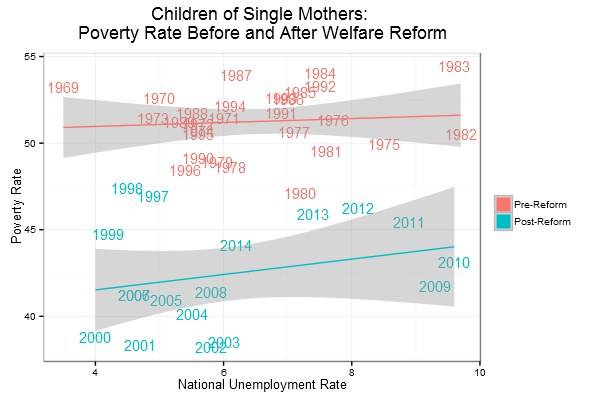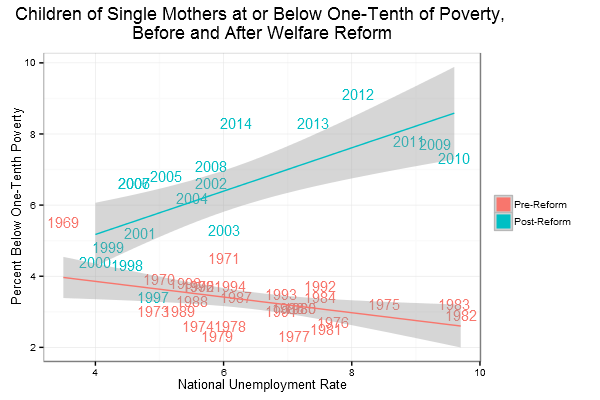Highlights
Thanks to the candidacy of Hillary Clinton, the debate over the 1996 welfare reform has returned this year. The battle lines could not be clearer.
The Manhattan Institute’s Scott Winship neatly summarized the conservative view in a piece last month entitled “Welfare Reform Reduced Poverty and No One Can Contest That”: By making cash welfare benefits temporary, the 1996 reform law encouraged more poor Americans to enter the labor force, which caused poverty rates to decline. Liberals, for their part, have long held a different view. The earliest critics of welfare reform attributed any drop in poverty to the strong economy of the late 1990s, not the law. More recently, the left has argued that welfare reform increased “extreme poverty” in particular—not poverty in general, not “deep poverty” (half the poverty line), but the state of living with almost no money whatsoever. That is the criticism, for example, that undergirds Annie Lowrey’s recent call in New York magazine to “bring welfare back.”
The reality is complicated, but both supporters and critics of the law have a point. Welfare reform indeed reduced poverty, particularly in single-mother families, but people who failed to find jobs did suffer. This tradeoff was built into the law itself: Those willing and able to find work could enjoy various forms of public support, while those who didn’t work lost access to many forms of assistance, especially cash. As the economist Robert Moffitt succinctly put it during a 2014 address, the shift from unconditional aid to work supports meant that “transfers fell for the worst-off single parents and rose for the better-off.”
This chart is one way of showing what the law did. It depicts the official poverty rate of children living with single mothers.1 To address the role of the economy, the numbers are plotted against the nationwide unemployment rate.2 (Please note that the Y-axis does not begin at zero.)

In the decades before welfare reform, about half of these children fell under the poverty line—and this didn’t change much when the economy did. After welfare reform, their poverty rate fell markedly. It did worsen with the Great Recession, as should be expected for an improvement that depends on the availability of work. But it never returned to its previous norm.
The official poverty line is hardly a perfect measure of a family’s well-being; for example, it doesn’t change to account for the additional costs that single mothers must shoulder when they work, such as transportation and child care. Cutting in the opposite direction, while it does include cash welfare benefits, the official poverty measure doesn’t include in-kind transfers or refundable tax credits, both of which have become more generous since welfare reform. In fact, total safety-net spending (including food stamps, the Earned Income Tax Credit, Medicaid, etc.) has grown substantially since the law was passed.
But nonetheless, these data unambiguously validate some of the major talking points of welfare-reform defenders. No, the sudden improvement in child poverty—which appears in more sophisticated poverty measures as well—wasn’t just a result of the economy; the relationship between the unemployment rate and these kids’ poverty rate fundamentally changed. And yes, many single mothers were able to find work when they had strong incentives to.
However, not everyone was able or willing to get a job, and that had consequences, too. Here is another version of the chart above, but instead of the poverty rate, it depicts the percentage of children of single mothers living at one-tenth of the poverty line or below.3 (That’s about $2,000 for a family of three this year, or $1.85 per person per day.) Once again, there is a marked shift after welfare reform, but things got worse instead of better.

In their research, as well as their book $2.00 a Day, sociologists Kathryn J. Edin and H. Luke Shaefer offer a finer-grained picture of what is happening here. They write that 4 percent of all families with children live on less than $2 per person per day in cash. This falls by half when they include food stamps and even more when they include some other programs, to land around 1.5 percent.
Critics have highlighted the fact that people underreport their welfare income on the government surveys Edin and Shaefer use, and that consumption tends to be much higher than income for the poor. So the picture that Edin and Shaefer paint—and the chart above—may overstate the problem as far as absolute deprivation goes. But as Edin and Shaefer show through in-depth profiles of people living in this new form of poverty, even with in-kind benefits available, cash is a necessity when it comes to things like paying bills and getting to job interviews. And it’s hardly surprising that a reform centered around work didn’t turn out well for people who didn’t find it.
The question, then, is not how to roll back welfare reform, but whether it’s possible to address cashless poverty without destroying the incentive structure that made welfare reform a success for so many. One option Edin and Shaefer propose is to limit states’ discretion over their cash-welfare grants, which some allege have been used to fix state budgets rather than help the poor. Another possibility would be to give some food-stamp benefits as cash instead. Further, if we expect the poor to work, we must ensure there are jobs available—and as National Review’s Reihan Salam pointed out in response to Lowrey’s piece, if the problem is a lack of jobs for the low-skill, we may want to reconsider our immigration policy as well.
A different solution would be to make the child tax credit fully refundable for all parents: guarantee universal access to $1,000 in cash per year per child, while cutting food stamps (and/or other aid) to partially compensate. An advantage of the child tax credit is that, unlike food stamps, it does not fade out as poor parents rise into the middle class, and therefore doesn’t act as an implicit tax on work. One disadvantage is that it lacks outright work requirements, though food stamps’ own requirements have been steadily weakened over the years. Another disadvantage is that it could provide an incentive for nonmarital childbearing.
Perhaps the biggest lesson of welfare reform is that these kinds of tradeoffs are inevitable: There is no perfect policy, only a least bad option. Welfare reform had costs as well as benefits, but it mostly helped the vulnerable population it affected. Future reforms should be made with an eye toward preserving those improvements.
Robert VerBruggen is editor of RealClearPolicy. Follow him on Twitter: @RAVerBruggen.
1. Data are from the Current Population Survey via IPUMS. Children of single mothers are defined as Americans age 0-17 who share a household with their mother but not a father or stepfather.
2. From FRED.
3. See the created variable “twoaday” in IPUMS.













